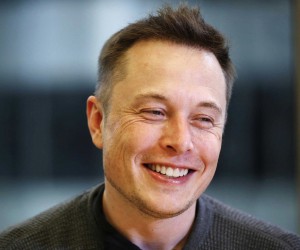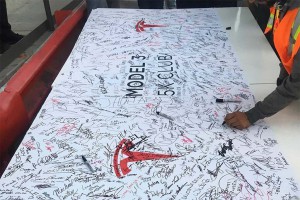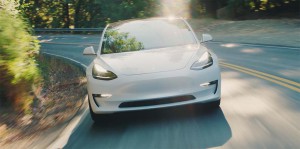What was supposed to be a great week for Tesla turned out to be anything but, with analysts and investors largely ignoring CEO Elon Musk’s jubilant announcement of hitting the company’s production target, instead turning increasingly bearish amidst a sharp stock sell-off.
The roller-coaster ride could continue during the next few weeks as Wall Street waits to see what Tesla will report when it releases its second-quarter earnings announcement. The company delivered record losses during the first three months of this year and is expected to remain deep in the red through the end of June. The longer-term question is whether Tesla’s rising production of the critical Model 3 battery-sedan will finally translate into the black ink and positive cash flow Musk has repeatedly promised.
For now, however, it appears that a growing number of analysts aren’t particularly optimistic. Of the 31 analysts who cover Tesla shares, 10 now offer “sell” guidance, nearly one in three. A roughly equal number list TSLA shares as “hold,” with only a third now recommending investors “buy.” It is rare, according to the Bloomberg news service, for analysts to go with a “sell” rating, most signaling displeasure with “hold” guidance.
Investors appear to be paying attention. The stock plunged nearly 50 points over the holiday week, closing Friday at $308.90. That’s well off Tesla’s 52-week low of $244.59, but also far behind its high of $389.61 during the same period.
(EV sales on the rise in the first half of 2018. Click Here for the story.)
That’s certainly not what CEO Musk was hoping for when he jubilantly announced that Tesla had ended the second quarter meeting its goal of producing 5,000 Model 3 sedans – and about 1,000 Model S and X battery-vehicles. Actually, that was just the latest in a series of revised goals Tesla had set for itself, the automaker once predicting it would roll out more than 400,000 vehicles this year. Instead, it suffered what Musk called “production hell” at its Fremont, California assembly plant, as well as at the Gigafactory battery plant in Reno, Nevada.
Tesla pulled out all the stops to get to the 5,000 total, even setting up an additional assembly line under a tent outside the already massive Fremont plant. But making the goal in a single week, coincidentally just at the end of the quarter, has left a lot of skeptics questioning what that really means. Key concerns focus on the carmaker’s ability to continue at that pace and, to some, the more important question of whether Tesla is sacrificing quality to make that goal. There have been some unverified reports the automaker has been skipping some tests to help speed up production.
While Tesla does claim to have hit the 5,000 goal, meanwhile, it still fell well short in other ways. It reported second-quarter production of 40,740 vehicles, 20% below the Wall Street consensus forecast of 51,120 electric vehicles. And while it may be boosting Model 3 production, sales for the quarter lagged at just 18,440. The consensus was that the coming would have sold 27,980 of its first compact model.
That’s all the more surprising considering Tesla’s claim to have a massive backlog of advance registrations for the Model 3. But while that bank was initially thought to be somewhere above 400,000, data website SecondMeasure reported last month that as many as 100,000 of those pre-orders have been cancelled, and it is widely expected that still more potential customers will back out the longer they have to wait.
(Click Here for more about Tesla meeting its goal of 5,000 Model 3 sedans in one week.)
At the production rate at the end of June, it would take about 80 weeks to supply those original orders, though Musk is now predicting the Fremont line will continue to ramp up output during the second half of the year. But even if Tesla somehow hit its original goal of 10,000 a week in the near-term – which analysts say is highly unlikely – some patient customers might not take delivery until mid- to late-2019 or beyond.
How investors will react this week remains far from certain. Musk has shown a flair for rallying the market with a few choice tweets, talk about future products and plans often generating a bullish surge even as hard economic data was swept aside.
“Tesla is the kind of company that pushes the analysts to take really strong opinions,” Michael Antonelli, an institutional equity sales trader and managing director at Robert W. Baird & Co., told Bloomberg. “This is a name that trades a lot on sentiment, and that sentiment changes minute by minute.”
Betting against Tesla, said one investor who asked not to be named, “is a risky move. You think you have all the facts behind you and short the stock but, instead, it bounces back.”
(Despite concerns, Musk promises “full Autopilot” coming this fall for Tesla. Click Here for the story.)
It has been barely months three months since Tesla’s stock bottomed out, tumbling by more than a third compared to its previous high. The current downturn would have to turn into a full-fledged rout to come close. Analysts say it’s more likely TSLA shares will bounce around in the coming weeks as everyone waits to see what the company’s second-quarter earnings looked like – and hear what Musk has to say about the future.




“..the next few weeks as Wall Street waits to see what Tesla will report when it releases its second-quarter earnings announcement.” How long does it take to come up with a report? Is a few weeks normal? Seems to me, other manufacturers are a bit more prompt.
Wall Street is for Wall Street. Nothing new there.
The SEC requires companies with a public float of at least $75 million to file earnings reports no more than 35 days after the end of the fiscal quarter, with the exception of the fourth quarter; in that case, they have 60 days to file both the fourth quarter earnings and the annual report. In other words, Tesla should announce its earnings by August 4. The estimated announcement date is August 1.